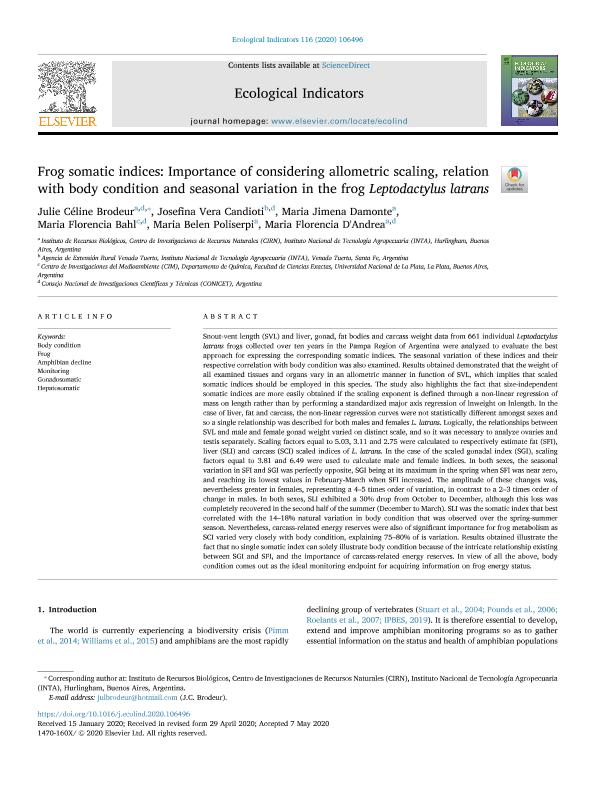Artículo
Frog somatic indices: Importance of considering allometric scaling, relation with body condition and seasonal variation in the frog Leptodactylus latrans
Brodeur, Celine Marie Julie ; Vera Candioti, Josefina
; Vera Candioti, Josefina ; Damonte, Maria Jimena; Bahl, Maria Florencia
; Damonte, Maria Jimena; Bahl, Maria Florencia ; Poliserpi, Maria Belen; D'andrea, María Florencia
; Poliserpi, Maria Belen; D'andrea, María Florencia
 ; Vera Candioti, Josefina
; Vera Candioti, Josefina ; Damonte, Maria Jimena; Bahl, Maria Florencia
; Damonte, Maria Jimena; Bahl, Maria Florencia ; Poliserpi, Maria Belen; D'andrea, María Florencia
; Poliserpi, Maria Belen; D'andrea, María Florencia
Fecha de publicación:
09/2020
Editorial:
Elsevier Science
Revista:
Ecological Indicators
ISSN:
1470-160X
Idioma:
Inglés
Tipo de recurso:
Artículo publicado
Clasificación temática:
Resumen
Snout-vent length (SVL) and liver, gonad, fat bodies and carcass weight data from 661 individual Leptodactylus latrans frogs collected over ten years in the Pampa Region of Argentina were analyzed to evaluate the best approach for expressing the corresponding somatic indices. The seasonal variation of these indices and their respective correlation with body condition was also examined. Results obtained demonstrated that the weight of all examined tissues and organs vary in an allometric manner in function of SVL, which implies that scaled somatic indices should be employed in this species. The study also highlights the fact that size-independent somatic indices are more easily obtained if the scaling exponent is defined through a non-linear regression of mass on length rather than by performing a standardized major axis regression of lnweight on lnlength. In the case of liver, fat and carcass, the non-linear regression curves were not statistically different amongst sexes and so a single relationship was described for both males and females L. latrans. Logically, the relationships between SVL and male and female gonad weight varied on distinct scale, and so it was necessary to analyze ovaries and testis separately. Scaling factors equal to 5.03, 3.11 and 2.75 were calculated to respectively estimate fat (SFI), liver (SLI) and carcass (SCI) scaled indices of L. latrans. In the case of the scaled gonadal index (SGI), scaling factors equal to 3.81 and 6.49 were used to calculate male and female indices. In both sexes, the seasonal variation in SFI and SGI was perfectly opposite, SGI being at its maximum in the spring when SFI was near zero, and reaching its lowest values in February-March when SFI increased. The amplitude of these changes was, nevertheless greater in females, representing a 4–5 times order of variation, in contrast to a 2–3 times order of change in males. In both sexes, SLI exhibited a 30% drop from October to December, although this loss was completely recovered in the second half of the summer (December to March). SLI was the somatic index that best correlated with the 14–18% natural variation in body condition that was observed over the spring-summer season. Nevertheless, carcass-related energy reserves were also of significant importance for frog metabolism as SCI varied very closely with body condition, explaining 75–80% of is variation. Results obtained illustrate the fact that no single somatic index can solely illustrate body condition because of the intricate relationship existing between SGI and SFI, and the importance of carcass-related energy reserves. In view of all the above, body condition comes out as the ideal monitoring endpoint for acquiring information on frog energy status.
Palabras clave:
AMPHIBIAN DECLINE
,
BODY CONDITION
,
FROG
,
GONADOSOMATIC
,
HEPATOSOMATIC
,
MONITORING
Archivos asociados
Licencia
Identificadores
Colecciones
Articulos (CIM)
Articulos de CENTRO DE INVESTIGACIONES DEL MEDIO AMBIENTE
Articulos de CENTRO DE INVESTIGACIONES DEL MEDIO AMBIENTE
Articulos(CCT - SANTA FE)
Articulos de CTRO.CIENTIFICO TECNOL.CONICET - SANTA FE
Articulos de CTRO.CIENTIFICO TECNOL.CONICET - SANTA FE
Articulos(SEDE CENTRAL)
Articulos de SEDE CENTRAL
Articulos de SEDE CENTRAL
Citación
Brodeur, Celine Marie Julie; Vera Candioti, Josefina; Damonte, Maria Jimena; Bahl, Maria Florencia; Poliserpi, Maria Belen; et al.; Frog somatic indices: Importance of considering allometric scaling, relation with body condition and seasonal variation in the frog Leptodactylus latrans; Elsevier Science; Ecological Indicators; 116; 9-2020; 1-9
Compartir
Altmétricas



